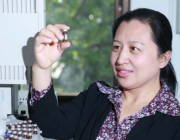摘要:
Particle number size distributions were simultaneously measured at the Guangzhou (GZ) urban site (23.13 degrees N, 113.26 degrees E) and the Back-garden (BG) rural site (23.5 degrees N, 113.03 degrees E) in the Pearl River Delta (PRD) region in July, 2006. It provided new findings into the evolution of particle number size distribution and new particle formation (NPF) in two different environments. Number concentration of particles (20 nm-10 mu m diameter) at GZ was about 70% higher than at BG and significantly affected by traffic emission. However, number concentrations of the regional aerosols (100-660 nm) were (6 +/- 3) x 10(3) cm(-3) at both sites. At BG, the diurnal variation of particle number size distributions showed an obvious particle growth process beginning at about 9:00 (LT), probably caused by NPF. In contrast, particle number concentrations in the size rages of 20-45 nm, 45-100 nm, and 100-660 nm showed similar trends with two main peaks at about 12:00 (LT) and 19:00 (LT) at GZ. NPF events were observed at both sites, but the occurrence frequency at GZ was about 50% lower than at BG. Regional NPF events at both sites probably in the same air mass were simultaneously observed with similar growth rates, concentrations and production rates of the condensable vapors, and condensational sinks on July 6. On the whole, deceasing traffic emission will improve air quality efficiently in the aspect of particle number concentration and fine particulate pollution in the summer of PRD should be controlled in a regional scale, especially with stagnant air mass from South China Sea. Crown Copyright (C) 2012 Published by Elsevier Ltd. All rights reserved.附注:
Sp. Iss. SI179PTTimes Cited:1Cited References Count:33